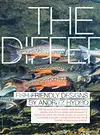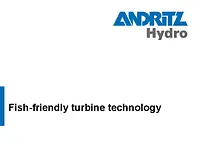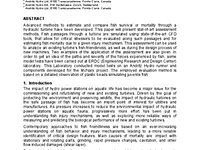Renewable Energy for Angola, Lauca
The Big Difference
Fish-Friendly Designs by ANDRITZ HYDRO
With top-notch environmental performance now a decisive factor for the owners and developers of hydropower plants, fish-friendly designs are becoming increasingly important considerations for the overall feasibility of hydropower projects.
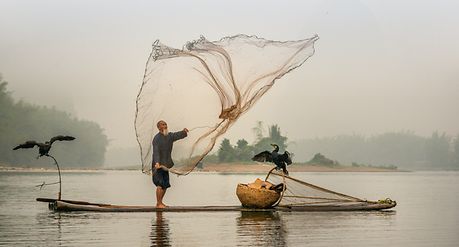
Decisions made during the early design stages of a project, such as those relating to the hydraulic and mechanical design of the turbines can have a dramatic effect on improving fish viability.
Among the many different topics that must be addressed to optimize a run-of-river hydropower project from an environmental point of view, fish migration is a highly significant issue for many water courses.
Fish migration usually occurs in order to feed or reproduce. For example, in upstream migration (anadromous fish migration), adult sea-dwelling species like salmon, striped bass and sturgeon return to their spawning grounds in the tributaries of large rivers.
Once a year, the adults of these species enter rivers and swim upstream, energetically clearing all obstacles and even waterfalls, to reach their destination where they produce fertilized eggs. The young eventually find their way downstream to the sea to mature into adulthood. Every fish faces many sources of danger during migration: professional or leisure fishing and natural predation, but also poor water quality due to pollution and local water temperature changes caused by cooling water discharge from the industry. Last but not least, hydroelectric power plants can also pose dangers to migrating fish.
As the intact fish population is not only basis of the livelihood of people living along the rivers and lakes, but is also main food source for animals, the sound fauna is essential for the economic welfare of thousands of people, sometimes for a whole region.
Possibilities to influence fish survival
From the first phases of plant design and layout, important parameters are set. For instance, during the powerhouse design phase when the number, type and size of the turbines are selected, many important decisions are made that can potentially reduce fish mortality. In particular, the hydraulic as well as the mechanical design of the turbines offers many opportunities to significantly and positively influence fish survival rates. In order to accurately assess different designs in terms of their fish mortality-related performance, comprehensive knowledge of injury mechanisms and their corresponding mitigation measures is necessary. Thorough studies also have to be conducted, forming the basis of the best hydropower solution for the ecology of the river.
Fish Survival Assessment
There are two kinds of hydropower related influences on fish mortality. Direct impacts due to physical injuries sustained during passage through the turbine; and indirect effects such as increased predation downstream of the discharge, and increased stress and/or disorientation after passage through the unit.
Since the 1990s, ANDRITZ HYDRO has followed a combined design strategy to ensure high rates of fish survival. Different design features are possible in connection to the various injury mechanisms caused by the different stressors (measurable, physical quantities that can be linked to each injury mechanism). It is worth noting that the optimal choice of design parameters for fish survival might be slightly different from those design considerations in which maximizing energy production or minimizing costs are the only targets.
Variable Speed

Optimal operating scheme

Variable speed 1) Bulb turbines with additional speed variation have very high efficiencies across a wide operating range whereas conventional double regulated turbines show high efficiency over a narrower operating range. This efficiency capability is one of the fundamental advantages of variable speed technology in reducing impacts on fish. For example, increased fish survival rates can be achieved by optimization of the operating scheme 2) for power plants. The strong relationship between the rates of fish survival, the discharge rate and fish length is one of most evident characteristics. During the migration season, recording the sizes of migrating fish allows plant operators to react by changing the operating scheme of the turbines to increase fish survival rates. The more information about fish migration behavior that is available, the more precisely the operating regime of the turbines can be adjusted during periods of significant migration.
Reduced gap runner

Reduced turbulence level

Reducing the gap 3) between rotating and stationary components can also boost survival rates by diminishing the risk of fish being trapped. This can be realized by using a fully spherical discharge ring to minimize the blade tip gap, using a spherical hub with “pockets” to minimize the hub gap.
Smaller gaps at the runner also diminish the turbulence level 4) in the draft tube. In general, turbulence in hydraulic passages can be separated between small and large-scale effects, which affect fish differently. Turbulence at small scales (length scales smaller than the fish length) is present in the same locations as high shear, and lead to similar injuries such as compression, stretching, and bending. Thus, small-scale turbulence injuries can usually be lumped together with shear stress injuries. Large scale turbulence (length scales longer than the fish) causes disorientation, hence increased stress on the fish. Such effects taken alone do not harm the fish, but increase the incidence of indirect mortality.
Minimum cavitation runner

Blunt leading edge

A minimum of cavitation 5) throughout the whole operating range is also essential for a fish-friendly design. Cavitation occurs when static pressure reaches the vapor pressure, leading to the formation of vapor bubbles. Reaching regions of higher pressure, these bubbles rapidly implode producing extremely energetic micro-jets, which may damage the runner blades and disrupt fish tissues, representing a potential cause of fish mortality. This is very much linked to rapid decompression, which is hazardous if two conditions are met. Firstly, the pressure must drop significantly lower than the pressure that the fish is acclimated to. Secondly, the pressure must drop more rapidly than the fish can accommodate such changes. These conditions usually occur where the absolute pressure can drop in a few instants to a fraction of a fish’s acclimation pressure.
A blunt leading edge 6) design may also allow a relevant increase in survival rates in particular for small-sized fish species in terms of the ratio of fish length to leading edge thickness. The optimal choice of the leading edge thickness will be achieved with the help of CFD simulations which also allow evaluating their influence on the performance and on the cavitation characteristic of the blade.
Aligning stay and guide vanes

Biological assessment tool

Aligning the stay and guide vanes 7) at least in the most important operating points reduces the probability that a fish will hit the wicket gate.
ANDRITZ HYDRO uses a biological assessment tool 8) supported by CFD to record the various stressors on a fish along its trajectory through an operating turbine. Based on in-depth knowledge of the stressor limits for injuries to various fish species, survival rates can be calculated with this assessment tool.
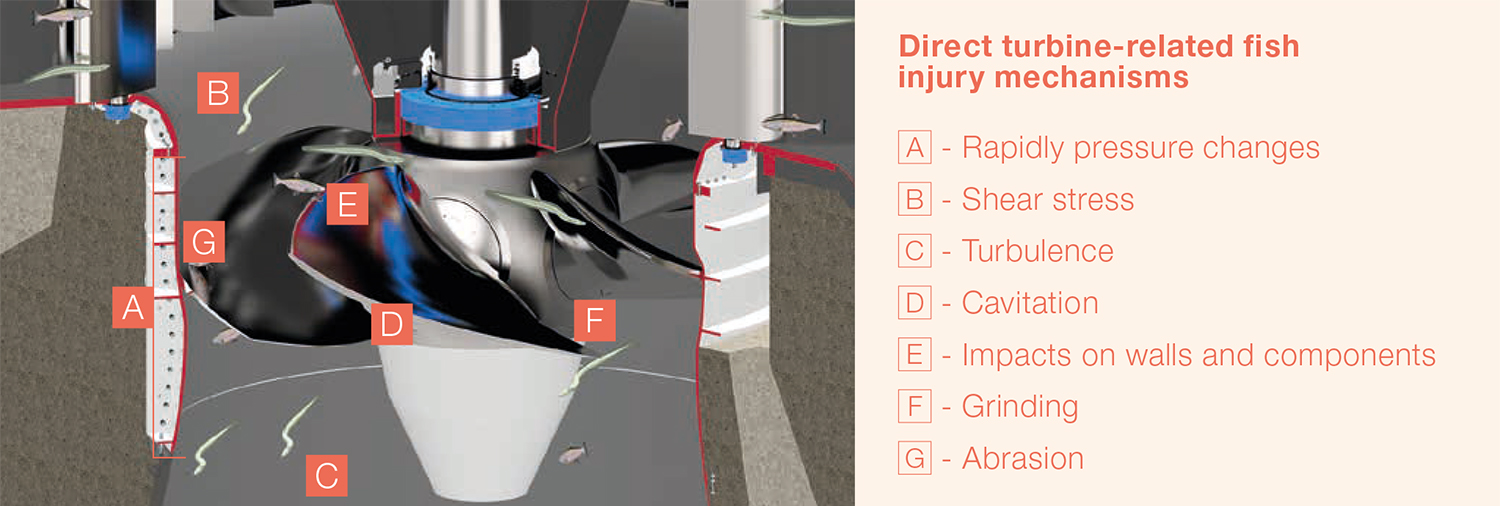
ANDRITZ HYDRO is fully committed to continuous development in regard to the fish friendliness of hydropower units and structures. Enhanced understanding of fish behavior and injury mechanisms to ensure more reliable identification of critical design features is a must and advanced methods to improve fish survival through a hydraulic turbine have been developed in conjunction with internationally active groups of biologists. Measures to improve fish survival are possible at all stages during the planning and design of a hydropower plant. Serious consideration of the many parameters affecting mortality rates and optimization of the tools and measures used to mitigate those impacts can have a dramatic and positive effect on the environmental performance of hydropower plants.
ANDRITZ HYDRO is ready to contribute!
Author: Andreas Rammler



